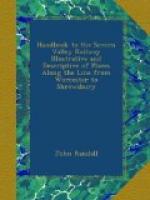“If thou wouldst view fair
Melrose aright,
Go visit it by the pale moonlight.
For the gay beams of lightsome day
Gild but to flout the ruins gray:
When the broken arches are black
in night,
And each shafted oriel glimmers
white;
When the cold light’s uncertain
shower
Streams on the ruin’d central
tower;
When buttress and buttress alternately
Seem framed of ebon and ivory.”
The traveller by the Severn Valley Railway can scarcely fail to notice here, and at other points along the line, beds of sand and gravel at levels above the highest points now reached by the river; wave-like sweeps of water-worn materials still higher up are no less conspicuous. In both these are found the Turritella terebra, and other shells of modern seas, identifying them with the period when a marine strait extended the whole distance from the Dee to the Bristol Channel. The cutting near Coalbrookdale has yielded a rich harvest of these marine remains, sufficient satisfactorily to indicate the true position of the beds, and to associate them with others of great interest elsewhere. Along one of the ancient estuaries of this recent sea, now the Vale of Shrewsbury, the Severn winds in curious curves, and almost meets in circles, imparting a pleasing aspect to the valley. On leaving Buildwas, Buildwas Park is passed on the left, and Leighton Hall and church are seen on the opposite side of the river; while on the left again are Shineton, Shinewood, and Bannister’s Coppice; the latter famous as the hiding-place of the Duke of Buckingham, when unable to cross the river with his army at its mouth. Shakspere alludes to the event, in “King Richard,” thus:—
“The news I have to tell your majesty Is, that by sudden flood and fall of waters, Buckingham’s army is dispersed and scatter’d, And he himself wandered away alone, No man knows whither.”
Tradition says that the fallen nobleman was betrayed by an old servant to whom the wood belonged, named Bannister; and an old writer thus records the curses which he says befel the traitor: “Shortly after he had betrayed his master, his sonne and heyre waxed mad, and dyed in a bore’s stye; his eldest daughter, of excellent beautie, was sodaynelie stryken with a foulle leperze; his seconde sonne very mervalously deformed of his limmes; his younger sonne in a smal puddell was strangled and drowned; and he, being of extreme age, arraigned and found gyltie of a murther, was only by his clergye saved; and as for his thousand pounde, Kyng Richard gave him not one farthing, saying that he which would be untrew to so good a master would be false to al other; howbeit some saie that he had a smal office or a ferme to stoppe his mouthe withal.”
[The Lady Oak: 36.jpg]




